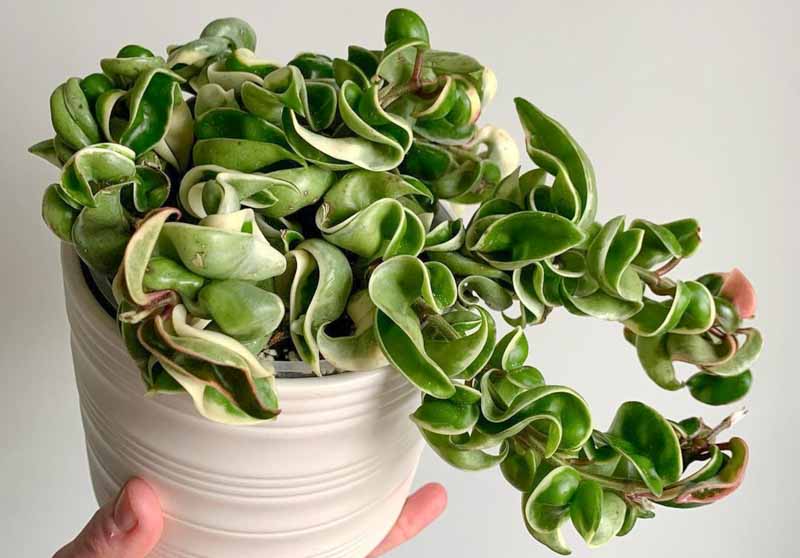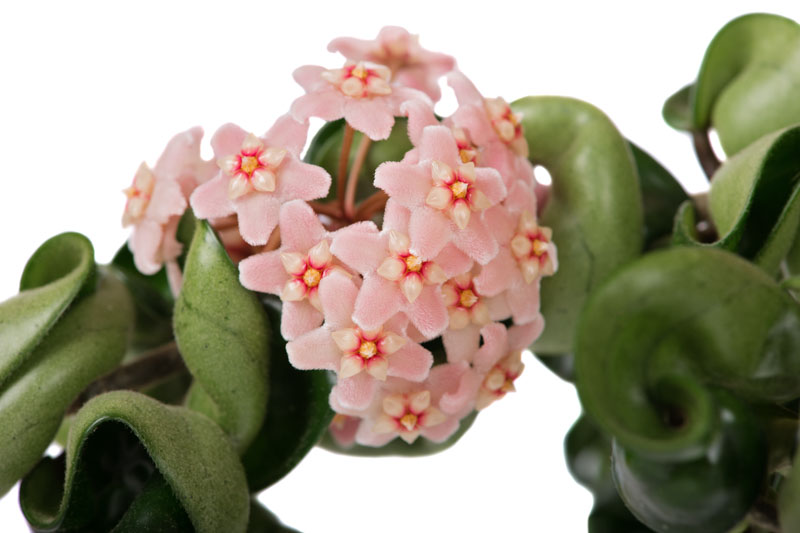Hindu Rope Plant, Porcelain Flower, Krinkle Kurl, Wax Plant, Hoya carnosa 'Compacta'
Hoya compacta, also known as the Hindu Rope Plant, is a distinctive and captivating variety of Hoya that is cherished for its unique, curled leaves and stunning, fragrant flowers.
Hoya compacta is known for its tightly curled, green leaves that form along vining stems, creating a rope-like appearance. This quirky growth habit makes it a standout among indoor plants. It is a unique variant of the wax plant or porcelain flower, scientifically known as Hoya carnosa.
Native: Originating from East Asia and Australia, Hoya compacta thrives in the warm, humid conditions typical of tropical and subtropical regions. It belongs to the dogbane family (Apocynaceae), along with plumeria, periwinkle, mandevilla, or oleander.
Plant Type and Habit: Hoya compacta is a slow-growing, semi-succulent, evergreen vine with a trailing or climbing habit. It is perfect for hanging baskets or as a climber with appropriate support.
Size: In a home setting, the Hindu rope plant grows 12-18 inches tall (30-45 cm) and 8-12 inches wide (20-30 cm). The compact nature of its curled leaves adds to its dense, lush appearance.
Hoya Flower: Hoya compacta produces clusters of sweetly fragrant, star-shaped, waxy flowers, typically pink or white with red centers. The blooms can add a delightful scent to any room. Flowering usually occurs in the warmer months, with proper care encouraging the plant to bloom repeatedly.
Fruit: Like other Hoyas, compacta can produce seed pods after successful pollination, though this is a rare occurrence in indoor environments.
Foliage: The plant’s most striking feature is its spiral, rope-like leaves arranged in opposite pairs. They are rigid, puckered and dark green.
Hardiness: It is best suited for warm indoor environments and can be grown outdoors in USDA hardiness zones 10-12.
Uses: Primarily grown for its ornamental appeal, the Hindu rope plant is a popular choice for indoor gardeners looking to add texture and uniqueness to their plant collections.
Toxicity: Hoya compacta is non-toxic to pets and humans, making it a safe addition to households with animals and children.
Invasiveness: It is not considered invasive, as it’s mostly grown in controlled indoor or greenhouse environments.
Benefits: Beyond its visual appeal, Hoya compacta is believed to purify the air, removing toxins and improving indoor air quality.

Growing and caring for Hoya compacta is rewarding due to its beautiful waxy foliage and fragrant flowers.
Light: Hoya compacta thrives in bright, indirect light. Direct sunlight can scorch the leaves, so it’s best to place it near a window with filtered light. If the light is too low, the plant may not produce flowers.
Soil: Use a well-draining potting mix. An orchid mix or a combination of potting soil, perlite, and peat is ideal. Hoya plants prefer to be slightly root-bound, so don’t rush to repot them.
Water: Water when the top inch of soil feels dry. Overwatering can lead to root rot, so ensure the pot has good drainage. Reduce watering in the winter when the plant is not actively growing.
Temperature and Humidity: Keep your Hoya compacta in average room temperatures—between 60°F and 85°F (15°C – 29°C). These plants appreciate high humidity. If your home is dry, consider using a humidifier or placing the pot on a pebble tray filled with water.
Fertilization: Feed with a balanced, water-soluble fertilizer every 4 weeks during the growing season (spring and summer). Dilute the fertilizer to half the recommended strength to avoid overfeeding, which can damage the plant.
Pruning: Prune to maintain shape or to remove unwanted tendrils. Be cautious not to remove the spurs from where flowers grow, as they will rebloom from the same place each year. The best time to prune is in early spring before its most rapid growth begins.
Flowering: To encourage blooming, allow the plant to become root-bound and provide adequate light. After blooming, avoid pruning the flower stalks, as Hoya will rebloom on old spurs.
Repotting: Repot your Hoya compacta every 2-3 years in spring, using a container slightly larger than the current one with fresh well-draining soil mix. Ensure the pot has drainage holes to prevent water from sitting and causing root rot.
Propagating Hoya compacta is quite simple and can be done using stem cuttings. Here’s how to do it:
Select a Stem: Choose a healthy stem with at least two leaves and one node (the place where leaves emerge from the stem).
Cut: Using a clean, sharp pair of scissors or pruning shears, cut just below a node.
Rooting Medium: You can root Hoya cuttings in either water or soil.
Environment: Place the cutting in a warm area with bright, indirect light.
Care: If rooted in soil, keep the soil consistently moist but not soggy. If in water, replace the water regularly.
Transplanting: Once the roots are a few inches long (if water rooting), or after a few weeks when the cutting has established roots in soil, transplant it to a pot with well-draining soil.
Aftercare: Care for the new Hoya plant as you would a mature one, but with slightly increased humidity and protection from direct sunlight until it is well established.

Hoya compacta is generally resilient, but like all plants, it may encounter pests and diseases.
Mealybugs: Look for white, cottony masses on stems and undersides of leaves. Remove with alcohol-dipped cotton swabs or apply insecticidal soap.
Scale insects: Hard, dome-shaped pests that attach firmly to stems and leaves, feeding on sap. Their presence can lead to yellowing leaves, stunted growth, and a decline in plant health.
Spider mites: Cause yellowing leaves and fine webs. Increase humidity and treat with miticide or insecticidal soap.
Root rot: Caused by overwatering and poor drainage. Ensure well-draining soil and allow the topsoil to dry out between waterings.
Gray mold or Botrytis: A gray mold that can affect leaves and stems, particularly in cool, damp conditions. Improve air circulation and reduce humidity.
Powdery mildew: White, powdery fungal growth on leaves. Improve air flow and treat with fungicides.
Leaf Yellowing: Can be due to overwatering, underfeeding, or insufficient light. Adjust care accordingly.
Leaf Drop: May occur if the plant is too dry, too cold, or experiencing a drastic change in environment.
No Blooms: Insufficient light or pruning off the peduncles (flower stalks) can prevent flowering. Hoyas should be mature enough and have ample light to bloom.
Wrinkled Leaves: Indicates dehydration. Water the plant thoroughly and consider increasing humidity around the plant.
Yes, Hoya compacta is known to be a slow-growing plant. Its unique, twisted leaves develop gradually, contributing to the plant’s appeal. Patience is key when growing this Hoya, as its striking appearance becomes more pronounced over time.
Hoya compacta has succulent-like qualities due to its thick, waxy leaves that store water, allowing the plant to withstand periods of drought. However, it’s technically not classified as a succulent but rather as an epiphytic plant that thrives in more humid, tropical environments.
To encourage blooming in Hoya compacta:
Yes, Hindu rope plants thrive in humid environments, similar to their natural tropical habitat. Maintaining indoor humidity levels around 40-60% will help keep your Hoya compacta healthy and may encourage flowering.
Hoya compacta requires bright, indirect light to thrive and potentially flower. Direct sunlight can scorch its leaves, while too little light can stunt growth and prevent blooming. A spot near an east or west-facing window, where the plant receives gentle morning or afternoon sunlight, is optimal.
| Hardiness |
10 - 12 |
|---|---|
| Plant Type | Houseplants |
| Plant Family | Apocynaceae |
| Genus | Hoya |
| Exposure | Partial Sun |
| Season of Interest |
Spring (Early, Mid, Late) Summer (Early, Mid, Late) Fall Winter |
| Height |
1' - 2' (30cm - 60cm) |
| Spread |
8" - 1' (20cm - 30cm) |
| Maintenance | Low |
| Water Needs | Average |
| Soil Type | Loam, Sand |
| Soil pH | Acid, Alkaline, Neutral |
| Soil Drainage | Well-Drained |
| Characteristics | Showy, Evergreen |
| Native Plants | Australia |
| Garden Uses | Hanging Baskets, Patio And Containers |
| Garden Styles | Mediterranean Garden |
| Hardiness |
10 - 12 |
|---|---|
| Plant Type | Houseplants |
| Plant Family | Apocynaceae |
| Genus | Hoya |
| Exposure | Partial Sun |
| Season of Interest |
Spring (Early, Mid, Late) Summer (Early, Mid, Late) Fall Winter |
| Height |
1' - 2' (30cm - 60cm) |
| Spread |
8" - 1' (20cm - 30cm) |
| Maintenance | Low |
| Water Needs | Average |
| Soil Type | Loam, Sand |
| Soil pH | Acid, Alkaline, Neutral |
| Soil Drainage | Well-Drained |
| Characteristics | Showy, Evergreen |
| Native Plants | Australia |
| Garden Uses | Hanging Baskets, Patio And Containers |
| Garden Styles | Mediterranean Garden |
How many Hoya compacta (Hindu Rope Plant) do I need for my garden?
| Plant | Quantity | |
|---|---|---|
| Hoya compacta (Hindu Rope Plant) | N/A | Buy Plants |
Create a membership account to save your garden designs and to view them on any device.
Becoming a contributing member of Gardenia is easy and can be done in just a few minutes. If you provide us with your name, email address and the payment of a modest $25 annual membership fee, you will become a full member, enabling you to design and save up to 25 of your garden design ideas.
Join now and start creating your dream garden!
Create a membership account to save your garden designs and to view them on any device.
Becoming a contributing member of Gardenia is easy and can be done in just a few minutes. If you provide us with your name, email address and the payment of a modest $25 annual membership fee, you will become a full member, enabling you to design and save up to 25 of your garden design ideas.
Join now and start creating your dream garden!